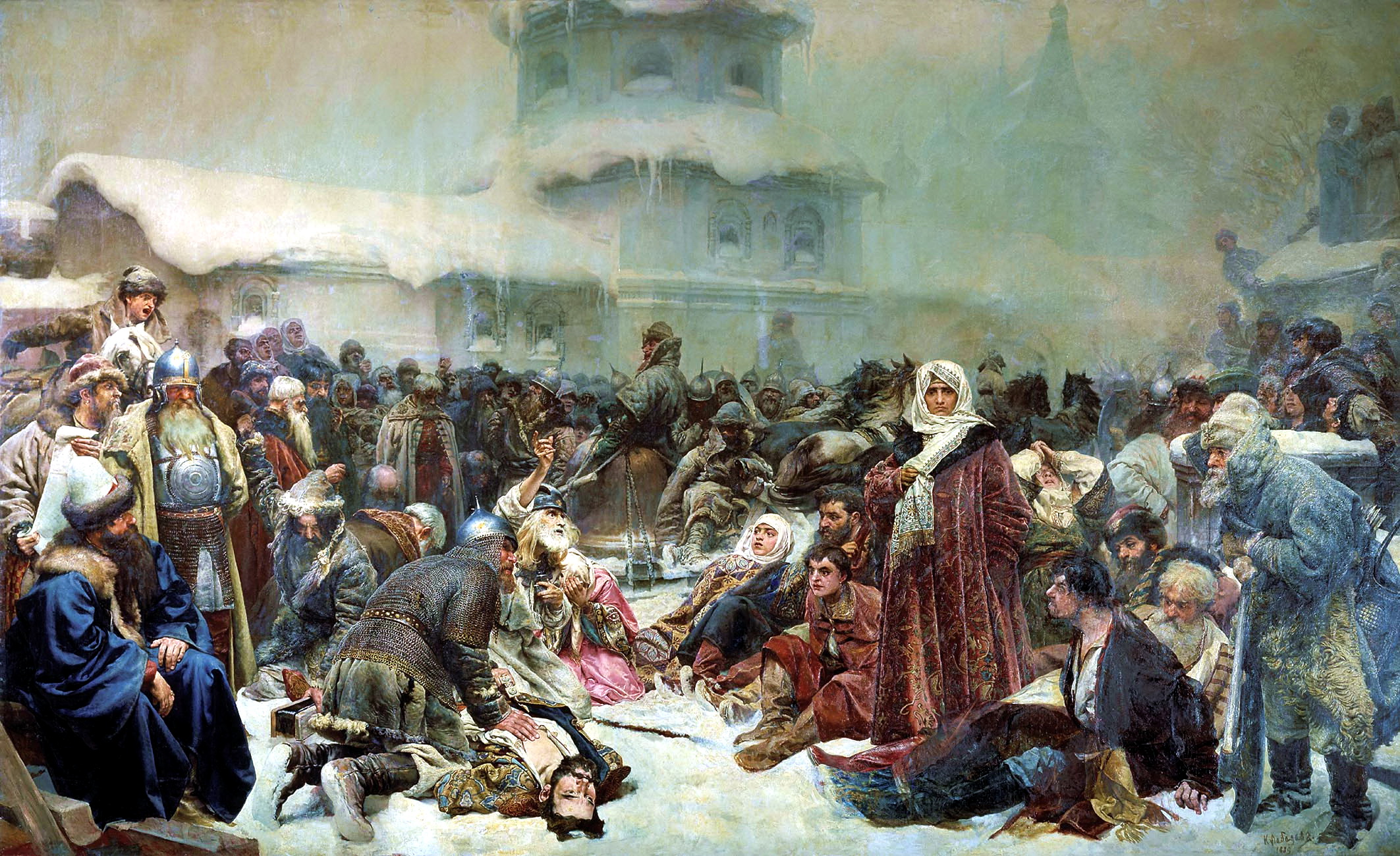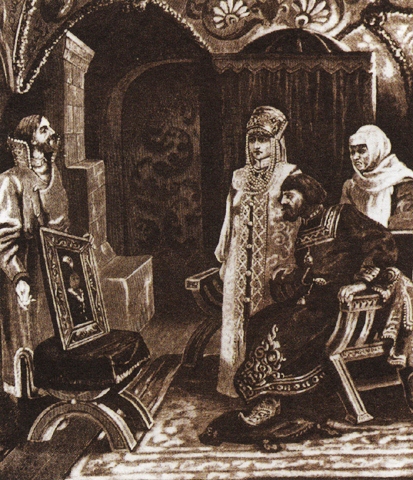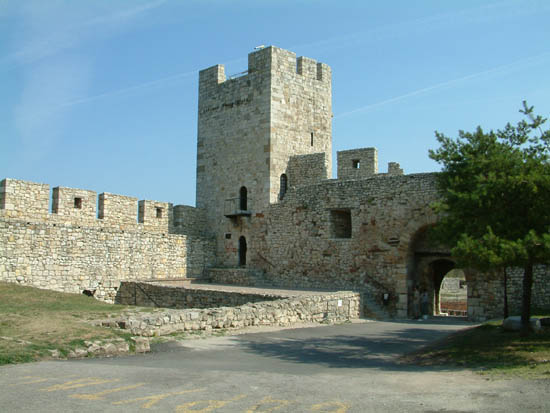|
Catherine Zaccaria
Catherine Zaccaria or Catherine Palaiologina ( grc-x-medieval, Αἰκατερίνα Παλαιολογίνα; died 26 August 1462) was the daughter of the last Prince of Achaea, Centurione II Zaccaria. In September 1429 she was betrothed to the Byzantine Despot of the Morea Thomas Palaiologos, and married him in January 1430 at Mystras. She remained in the Morea as Thomas' consort until the Ottoman conquest in 1460, after which she fled to the Venetian-held island of Corfu. There she died on 26 August 1462, being buried in the Monastery of Jason and Sosipatros. By her marriage with Thomas, she had four children, the sons Andreas and Manuel and the daughters Helena (wife of Lazar Branković of Serbia Serbia (, ; Serbian language, Serbian: , , ), officially the Republic of Serbia (Serbian language, Serbian: , , ), is a landlocked country in Southeast Europe, Southeastern and Central Europe, situated at the crossroads of the Pannonian Bas ...) and Zoe (wife of Ivan III ... [...More Info...] [...Related Items...] OR: [Wikipedia] [Google] [Baidu] |
Prince Of Achaea
The Prince of Achaea was the ruler of the Principality of Achaea, one of the crusader states founded in Greece in the aftermath of the Fourth Crusade (1202–1204). Though more or less autonomous, the principality was never a fully independent state, initially being a vassal state subservient of the Latin Empire of Constantinople, which had supplanted the Byzantine Empire, and later of the Angevin Kingdom of Naples. During the Angevin period, the princes were often absent, being represented in the Principality by their '' baillis'', who governed in their name. The principality was one of the longest-lasting of the Latin states in Greece, outliving the Latin Empire itself by 171 years. It did not come to an end until 1432, when the Byzantine prince Thomas Palaiologos inherited the last remnants of the Principality through marriage to the daughter of the last prince, Centurione Zaccaria. With the Principality gone, the title of Prince of Achaea became vacant. The title was reviv ... [...More Info...] [...Related Items...] OR: [Wikipedia] [Google] [Baidu] |
Helena Palaiologina, Despotitsa Of Serbia
Helena Palaiologina ( gr, Ελένη Παλαιολογίνα, sr, Јелена Палеолог/Jelena Paleolog; 1431 – 7 November 1473) was a Byzantine princess who married Serbian Despot Lazar Branković, who ruled from 1456 until his death in 1458. After Smederevo fell to the Ottoman Turks on 20 June 1459, she fled Serbia for the Greek island of Leukas, where she converted to Catholicism. She is not to be confused with her grandmother, Helena Dragaš, a Serbian princess who was the mother of the last two Eastern Roman Emperors and who became a nun and a Saint of the Eastern Orthodox Church. Family Helena was born in the Despotate of the Morea in 1431, the eldest daughter and child of Thomas Palaiologos, Despot of the Morea and Catherine Zaccaria of Achaea. She had two younger brothers, Andreas Palaiologos and Manuel Palaiologos, and a sister, Zoe, who would become the wife of Ivan III of Russia. Her maternal grandparents were Centurione II Zaccaria and Creus ... [...More Info...] [...Related Items...] OR: [Wikipedia] [Google] [Baidu] |
Zaccaria Family
The Zaccaria family was an ancient and noble Genoese dynasty that had great importance in the development and consolidation of the Republic of Genoa in the thirteenth century and in the following period. The Zaccarias were characterized by, according to scholarly handwritten documents of the time, having broad intelligence and their effective way of maintaining political power through manipulation. History The Zaccaria family was a very prominent family in the Republic of Genoa. Also following the Treaty of Nymphaeum of 1261, Michael VIII Palaiologos granted the Genoese the commercial exploitation of the Empire of Nicaea, as a reward for the help received in the recovery of the Byzantine Empire, and, more generally, in an anti- Venetian function. In this scenario, the Zaccaria family, in 1275 , assumed the lordship of Phocaea, first with Manuele then with his son Tedisio and, then, with Benedetto I Zaccaria. Phocaea was an important commercial port, with its hinterland rich in a ... [...More Info...] [...Related Items...] OR: [Wikipedia] [Google] [Baidu] |
Palaiologos Dynasty
The House of Palaiologos ( Palaiologoi; grc-gre, Παλαιολόγος, pl. , female version Palaiologina; grc-gre, Παλαιολογίνα), also found in English-language literature as Palaeologus or Palaeologue, was a Byzantine Greek family that rose to nobility and produced the last and longest-ruling dynasty in the history of the Byzantine Empire. Their rule as Emperors and Autocrats of the Romans lasted almost two hundred years, from 1259 to the Fall of Constantinople in 1453. The origins of the family are unclear. Their own medieval origin stories ascribed them an ancient and prestigious origin in ancient Roman Italy, descended from some of the Romans that had accompanied Constantine the Great to Constantinople upon its foundation in 330. It is more likely that they originated significantly later in Anatolia since the earliest known member of the family, possibly its founder, Nikephoros Palaiologos, served as a commander there in the second half of the 11th cent ... [...More Info...] [...Related Items...] OR: [Wikipedia] [Google] [Baidu] |
Despotate Of The Morea
The Despotate of the Morea ( el, Δεσποτᾶτον τοῦ Μορέως) or Despotate of Mystras ( el, Δεσποτᾶτον τοῦ Μυστρᾶ) was a province of the Byzantine Empire which existed between the mid-14th and mid-15th centuries. Its territory varied in size during its existence but eventually grew to include almost all the southern Greek peninsula now known as the Peloponnese, which was known as the Morea during the medieval and early modern periods. The territory was usually ruled by one or more sons of the current Byzantine emperor, who were given the title of ''despotes'' (in this context it should not be confused with despotism). Its capital was the fortified city of Mystras, near ancient Sparta, which became an important centre of the Palaiologan Renaissance. History The Despotate of the Morea was created out of territory seized from the Frankish Principality of Achaea. This had been organized from former Byzantine territory after the Fourth Crusad ... [...More Info...] [...Related Items...] OR: [Wikipedia] [Google] [Baidu] |
1462 Deaths
146 may refer to: *146 (number), a natural number *AD 146, a year in the 2nd century AD *146 BC, a year in the 2nd century BC *146 (Antrim Artillery) Corps Engineer Regiment, Royal Engineers 146 may refer to: *146 (number), a natural number *AD 146, a year in the 2nd century AD *146 BC __NOTOC__ Year 146 BC was a year of the pre-Julian Roman calendar. At the time it was known as the Year of the Consulship of Lentulus and Achaicus ( ... See also * List of highways numbered 146 * {{Number disambiguation ... [...More Info...] [...Related Items...] OR: [Wikipedia] [Google] [Baidu] |
15th-century Births
The 15th century was the century which spans the Julian dates from 1 January 1401 ( MCDI) to 31 December 1500 ( MD). In Europe, the 15th century includes parts of the Late Middle Ages, the Early Renaissance, and the early modern period. Many technological, social and cultural developments of the 15th century can in retrospect be seen as heralding the " European miracle" of the following centuries. The architectural perspective, and the modern fields which are known today as banking and accounting were founded in Italy. The Hundred Years' War ended with a decisive French victory over the English in the Battle of Castillon. Financial troubles in England following the conflict resulted in the Wars of the Roses, a series of dynastic wars for the throne of England. The conflicts ended with the defeat of Richard III by Henry VII at the Battle of Bosworth Field, establishing the Tudor dynasty in the later part of the century. Constantinople, known as the capital of the world ... [...More Info...] [...Related Items...] OR: [Wikipedia] [Google] [Baidu] |
Ivan III Of Russia
Ivan III Vasilyevich (russian: Иван III Васильевич; 22 January 1440 – 27 October 1505), also known as Ivan the Great, was a Grand Prince of Moscow and Grand Prince of all Rus'. Ivan served as the co-ruler and regent for his blind father Vasily II from the mid-1450s before he officially ascended the throne in 1462. He multiplied the territory of his state through war and through the seizure of lands from his dynastic relatives, ended the dominance of the Tatars over Russia, renovated the Moscow Kremlin, introduced a new legal codex and laid the foundations of the Russian state. His 1480 victory over the Great Horde is cited as the restoration of Russian independence, 240 years after the fall of Kiev in the Mongol invasion of Kievan Rus'. Ivan was the first Russian ruler to style himself " tsar", albeit not as an official title. Through marriage to Sofia Paleologue, he made the double-headed eagle Russia's coat of arms and adopted the idea of Moscow as ... [...More Info...] [...Related Items...] OR: [Wikipedia] [Google] [Baidu] |
Zoe Palaiologina
Zoe Palaiologina ( grc-x-byzant, Ζωή Παλαιολογίνα), whose name was later changed to Sophia Palaiologina (russian: София Фоминична Палеолог; ca. 1449 – 7 April 1503), was a Byzantine princess, member of the Imperial Palaiologos family, and Grand Princess of Moscow as the second wife of Grand Prince Ivan III. Through her eldest son, Vasili III, she was the grandmother of Ivan the Terrible, the first Tsar of All Russia. Family Zoe was born in the Morea in 1449. Her father was Thomas Palaiologos, Despot of the Morea and younger brother of the last Byzantine Emperor, Constantine XI Palaiologos (). Her mother was Catherine, the only legitimate daughter and heiress of Centurione II Zaccaria, the last independent Prince of Achaea and Baron of Arcadia. The marriage between Thomas Palaiologos and Catherine Zaccaria produced four children: Helena (later wife of Lazar Branković, Despot of Serbia), Zoe, Andreas, and Manuel. In Italy The f ... [...More Info...] [...Related Items...] OR: [Wikipedia] [Google] [Baidu] |
Serbian Despotate
The Serbian Despotate ( sr, / ) was a medieval Serbian state in the first half of the 15th century. Although the Battle of Kosovo in 1389 is generally considered the end of medieval Serbia, the Despotate, a successor of the Serbian Empire and Moravian Serbia, lasted for another 60 years, experiencing a cultural and political renaissance before it was conquered by the Ottomans in 1459. Before its conquest the Despotate was a tributary state of the neighbouring Byzantine Empire, Ottoman Empire, and Kingdom of Hungary, all of which considered it to be part of their sphere of influence. After 1459, political traditions of the Serbian Despotate continued to exist in exile, in the medieval Kingdom of Hungary, with several titular despots of Serbia, who were appointed by kings of Hungary. The last titular Despot of Serbia was Pavle Bakić, who fell in the Battle of Gorjani. History Origins After Prince Lazar Hrebeljanović was killed in the Battle of Kosovo on June 28, 13 ... [...More Info...] [...Related Items...] OR: [Wikipedia] [Google] [Baidu] |
Lazar Branković
Lazar Branković ( sr-cyr, Лазар Бранковић; c. 1421 – 20 February 1458) was a Serbian despot, prince of Rascia from 1456 to 1458. He was the third son of Đurađ Branković and his wife Eirene Kantakouzene. He was succeeded by his elder brother, despot Stefan III Branković. Biography Both Grgur and Stefan, his older brothers, were blinded by orders of Murad II in 1441. Lazar apparently became the heir to their father as the only son not to be handicapped. Đurađ died on 24 December 1456. Lazar succeeded him as planned. According to Fine, his brief reign mostly included family quarrels with his mother and siblings. In 1457, Lazar gave an oath of subservience to Mehmed II, son and successor of Murad II. Fine considers this to be an attempt to prevent an Ottoman invasion. His only other decision of consequence was to appoint Mihailo Anđelović, a member of the Angelos family, as his chief official. Mihailo briefly served as head of a regency council following th ... [...More Info...] [...Related Items...] OR: [Wikipedia] [Google] [Baidu] |
Manuel Palaiologos
Manuel Palaiologos or Palaeologus ( el, Μανουήλ Παλαιολόγος, translit=Manouēl Palaiologos; 2 January 1455 – before 1513) was the youngest son of Thomas Palaiologos, a brother of Constantine XI Palaiologos, the final Byzantine emperor. Thomas took Manuel and the rest of his family to Corfu after the Fall of Constantinople in 1453 and the subsequent Ottoman invasion of the Morea in 1460. After Thomas's death in 1465, the children moved to Rome, where they were initially taken care of by Cardinal Bessarion and were provided with money and housing by the papacy. The money provided by the papacy was gradually cut back and Manuel eventually left Rome in 1474 in order to seek his fortune by offering military service to various nobles and rulers in Europe, including Galeazzo Maria Sforza of Milan and Charles the Bold of Burgundy. Disappointed with the offers he received, and with the papacy cutting the money back further, Manuel surprised the establishment in Ro ... [...More Info...] [...Related Items...] OR: [Wikipedia] [Google] [Baidu] |
.jpg)




